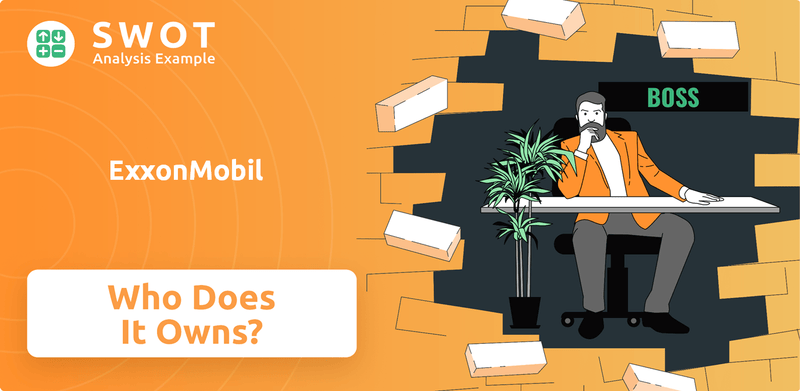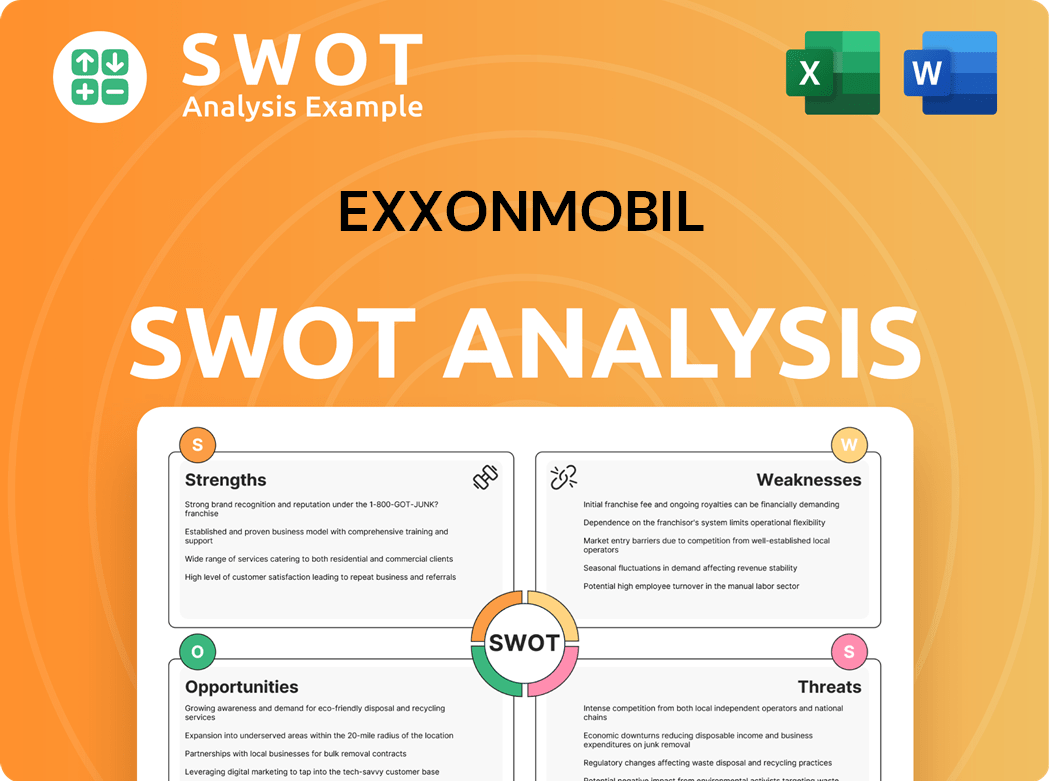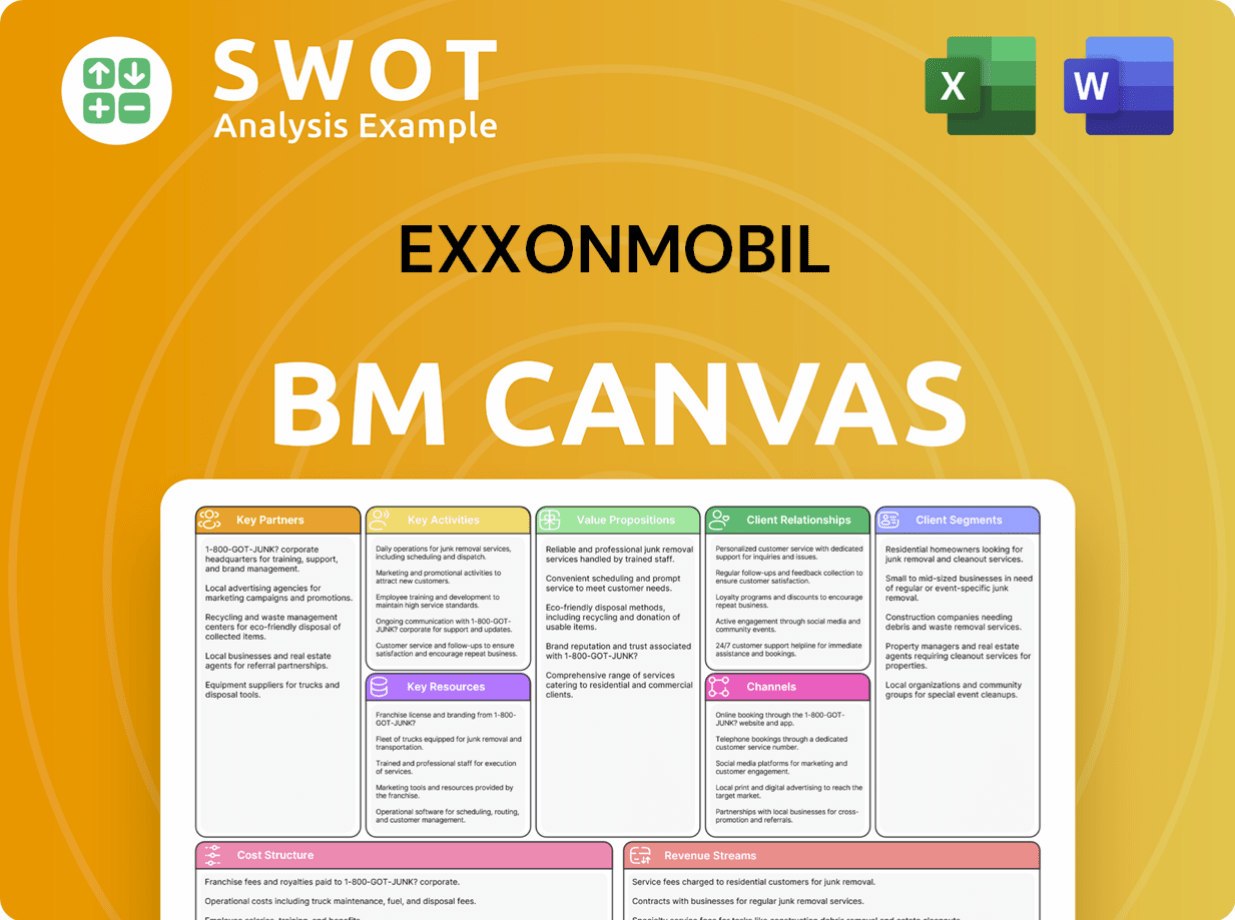ExxonMobil Bundle
Who Truly Owns ExxonMobil?
Unraveling the ExxonMobil SWOT Analysis reveals critical insights, but understanding its ownership is paramount. The ownership structure of ExxonMobil dictates its strategic moves, from its board of directors to its long-term investments. This exploration dives deep into the evolution of ExxonMobil's ownership, tracing its roots from the Standard Oil era to its current status as a global energy giant.

Understanding who owns ExxonMobil is crucial for anyone interested in the company's future. Examining the ExxonMobil ownership reveals the influence of major shareholders, the impact of public stock ownership, and the overall ExxonMobil company structure. This analysis will clarify the dynamics of ExxonMobil shareholders and their roles in shaping the company's direction, offering a comprehensive view of how ExxonMobil stock ownership translates to power and influence.
Who Founded ExxonMobil?
The story of ExxonMobil ownership begins with the Standard Oil Company, established in 1870. This foundation laid the groundwork for what would become one of the world's largest energy companies. Understanding the early ownership structure is key to grasping its evolution and the subsequent shifts in its shareholder base.
John D. Rockefeller and his partners were the original founders of Standard Oil. Their vision and strategic moves shaped the company's early dominance in the oil industry. This initial ownership group's decisions set the stage for the company's future growth and the eventual restructuring that led to the formation of Exxon and Mobil.
The initial capitalization of Standard Oil in 1870 was $1 million. By 1878, Standard Oil controlled an estimated 95% of the US refining capacity. This remarkable control was a direct result of Rockefeller's strategies, underscoring the impact of early ownership decisions.
In 1882, the Standard Oil Trust was formed to bypass state laws. This move allowed the company to consolidate its control across state lines.
The Sherman Antitrust Act of 1890 was largely a response to Standard Oil's monopolistic practices. This act aimed to curb anti-competitive behaviors.
In 1911, the U.S. Supreme Court ordered the dissolution of the Standard Oil Trust. This decision broke the trust into 34 independent companies.
Jersey Standard (later Exxon) and Socony (later Mobil) were two of the most significant spin-off companies. These companies emerged from the breakup.
Henry Flagler and John Archbold were key figures in the early development of Exxon (Jersey Standard). Charles Pratt and Henry Rogers led Mobil (Socony).
The original ownership group largely remained consistent across the newly formed entities. This continuity ensured a smooth transition.
The breakup of Standard Oil in 1911 was a pivotal moment in the history of ExxonMobil ownership. The resulting independent companies, including Jersey Standard (Exxon) and Socony (Mobil), maintained much of the original ownership structure. Key figures like Henry Flagler and John Archbold at Jersey Standard, and Charles Pratt and Henry Rogers at Socony, continued to shape the direction of these newly formed entities. This history offers insights into Brief History of ExxonMobil, and provides context for understanding who owns ExxonMobil and the evolution of its shareholder base over time. The early decisions made by these individuals and the initial ownership structure laid the foundation for the company's future success and its position in the global energy market. As of early 2024, the company continues to be a publicly traded entity, with its shares held by a diverse group of institutional and individual investors.
Understanding the early ownership of ExxonMobil provides a crucial context for the company's current structure and shareholder base.
- Founding: John D. Rockefeller and partners founded Standard Oil in 1870.
- Early Dominance: By 1878, Standard Oil controlled approximately 95% of US refining capacity.
- Trust Formation: The Standard Oil Trust was created in 1882 to circumvent state laws.
- Antitrust Action: The Sherman Antitrust Act of 1890 targeted Standard Oil's monopolistic practices.
- Dissolution: In 1911, the Supreme Court ordered the breakup of Standard Oil into 34 companies.
- Key Spin-offs: Jersey Standard (Exxon) and Socony (Mobil) were significant spin-offs.
- Leadership: Key figures like Henry Flagler and John Archbold led Jersey Standard.
- Ownership Continuity: The original ownership group largely remained consistent across the new entities.
ExxonMobil SWOT Analysis
- Complete SWOT Breakdown
- Fully Customizable
- Editable in Excel & Word
- Professional Formatting
- Investor-Ready Format

How Has ExxonMobil’s Ownership Changed Over Time?
The formation of the company in 1999, through the merger of Exxon and Mobil, significantly reshaped its ownership structure. This pivotal event, spearheaded by then-CEOs Lee Raymond of Exxon and Lucio Noto of Mobil, created a single entity that consolidated the assets and shareholder bases of the two oil giants. This merger was a landmark event in the energy sector, influencing the future of the Growth Strategy of ExxonMobil.
As a publicly traded company, the ownership of the company has evolved over time. The majority of shares are held by institutional investors, reflecting the company's status as a key player in the global energy market. This structure influences company strategy and governance, with a focus on long-term value creation.
| Ownership Category | Approximate Percentage (May 2025) | Notes |
|---|---|---|
| Institutional Investors | 66.69% | Includes investment firms, mutual funds, and other institutions. |
| Retail Investors | 35.16% | Individual investors holding shares. |
| Insiders | 0.82% | Includes company executives and board members. |
The major shareholders of the company, as of March 31, 2025, show the dominance of institutional investors. Vanguard Group Inc. holds approximately 9.98% of the company, with a value of around $46.10 billion as of December 2, 2024. BlackRock Inc. holds about 7.02%, and State Street Corp. holds about 4.98%. Other significant institutional investors include Fmr LLC, Geode Capital Management LLC, JPMorgan Chase & Co., Morgan Stanley, Bank of America Corp., Bank of New York Mellon Corp., and Northern Trust Corp.
The ownership of the company is primarily held by institutional investors, reflecting its status as a major player in the energy sector. These institutional investors significantly influence company strategy and governance.
- Vanguard Group Inc. is a major shareholder, holding a significant percentage of the company's stock.
- BlackRock Inc. and State Street Corp. are also key institutional investors.
- Individual insider ownership, such as that of Neil Chapman, is a smaller but still relevant portion.
- The ownership structure impacts the company's focus on long-term value and ESG factors.
ExxonMobil PESTLE Analysis
- Covers All 6 PESTLE Categories
- No Research Needed – Save Hours of Work
- Built by Experts, Trusted by Consultants
- Instant Download, Ready to Use
- 100% Editable, Fully Customizable

Who Sits on ExxonMobil’s Board?
The current board of directors at ExxonMobil is pivotal in overseeing the company's strategy and governance. The board's operations adhere to Corporate Governance Guidelines, which mandate that all directors are up for election at the annual shareholder meeting. The board generally comprises approximately 11 to 13 members, with a significant majority being independent directors. As of May 31, 2024, shareholders elected all twelve director nominees, with high 'For' vote percentages. For instance, Michael J. Angelakis received 96.8% 'For' votes, and Angela F. Braly received 94.6% 'For' votes.
The board's composition and the voting outcomes reflect the influence of various shareholders and the company's commitment to maintaining a robust governance structure. This structure is crucial for the long-term success and strategic direction of ExxonMobil. Understanding the board's dynamics is key to grasping the company's approach to major decisions and its response to shareholder concerns. Knowing the Marketing Strategy of ExxonMobil is also important.
| Director | Role | 'For' Vote Percentage (May 2024) |
|---|---|---|
| Michael J. Angelakis | Director | 96.8% |
| Angela F. Braly | Director | 94.6% |
| Other Directors | Directors | Various percentages, all above majority |
The voting structure for ExxonMobil's common stock typically operates on a one-share, one-vote basis. There are no public indications of dual-class shares or special voting rights that would grant disproportionate control to specific individuals or entities beyond their shareholding percentage. The board's primary duty is to exercise business judgment in the best interests of ExxonMobil's shareholders. This structure ensures that the company's decisions are aligned with the interests of its investors, promoting long-term value creation and stability. In the 2024 AGM, some investors voted against the re-election of some directors, although all were re-elected with majorities.
ExxonMobil's board of directors plays a crucial role in the company's governance, with all directors up for election annually.
- The board aims for 11-13 members, mostly independent.
- Voting is generally one-share, one-vote, ensuring shareholder alignment.
- Activist investors continue to influence the company's strategic direction.
- Shareholder proposals were absent from the ballot for the May 2025 annual general meeting.
ExxonMobil Business Model Canvas
- Complete 9-Block Business Model Canvas
- Effortlessly Communicate Your Business Strategy
- Investor-Ready BMC Format
- 100% Editable and Customizable
- Clear and Structured Layout

What Recent Changes Have Shaped ExxonMobil’s Ownership Landscape?
Over the past few years, significant financial maneuvers have reshaped the ExxonMobil ownership landscape. The company has consistently returned capital to its shareholders, with a share repurchase program planned to continue through 2026. In the first quarter of 2025, ExxonMobil repurchased $4.8 billion in shares, contributing to total shareholder distributions of $9.1 billion, which also included $4.3 billion in dividends. This commitment is part of a larger trend, with over $125 billion distributed to shareholders through dividends and buybacks over the last five years. The company has also increased its annual dividend for 42 consecutive years, with a quarterly payout of $0.99 per share declared for the second quarter of 2025.
Strategic acquisitions have also influenced the company's structure. The completion of the Denbury acquisition in November 2023 and Pioneer Natural Resources Company in May 2024 has expanded its asset base. These moves may influence future ownership structures through stock-based transactions. Furthermore, ExxonMobil plans to invest between $27 billion and $29 billion in 2025, and between $28 billion and $33 billion annually from 2026 to 2030, balancing traditional energy ventures with lower-emissions opportunities. These investments, combined with shareholder distributions, shape the company's financial outlook and investor appeal.
Institutional investors currently hold a significant portion of ExxonMobil's shares. In May 2025, institutional investors held 66.69% of the company's shares, mirroring the figures from previous months in 2025. This high level of institutional ownership, especially from major asset managers like Vanguard and BlackRock, often leads to a greater emphasis on ESG concerns and corporate governance. The company's recent legal actions against activist shareholders in 2024 highlight the growing impact of such groups on corporate decision-making, particularly regarding climate change strategies. This level of ownership affects who owns ExxonMobil and how decisions are made.
Institutional investors, including major asset managers, hold a substantial portion of ExxonMobil's stock, influencing corporate decisions. Individual investors also hold shares, though their percentage is smaller than institutional holdings. Understanding who the major shareholders are provides insight into the company's strategic direction.
The ownership structure includes institutional investors, individual shareholders, and potentially shares held by company executives and board members. Publicly available data provides details on major shareholders and their holdings. Analyzing this breakdown helps in understanding the company's control dynamics.
Major institutional investors and the board of directors significantly influence ExxonMobil's strategic decisions. The CEO and executive team also play a crucial role in shaping the company's direction. Shareholders' voting power and influence are important factors.
Shareholder data can be found in SEC filings, annual reports, and financial news sources. Institutional ownership details are available from financial data providers. These resources offer a comprehensive view of the company's ownership structure.
ExxonMobil Porter's Five Forces Analysis
- Covers All 5 Competitive Forces in Detail
- Structured for Consultants, Students, and Founders
- 100% Editable in Microsoft Word & Excel
- Instant Digital Download – Use Immediately
- Compatible with Mac & PC – Fully Unlocked

Related Blogs
- What are Mission Vision & Core Values of ExxonMobil Company?
- What is Competitive Landscape of ExxonMobil Company?
- What is Growth Strategy and Future Prospects of ExxonMobil Company?
- How Does ExxonMobil Company Work?
- What is Sales and Marketing Strategy of ExxonMobil Company?
- What is Brief History of ExxonMobil Company?
- What is Customer Demographics and Target Market of ExxonMobil Company?
Disclaimer
All information, articles, and product details provided on this website are for general informational and educational purposes only. We do not claim any ownership over, nor do we intend to infringe upon, any trademarks, copyrights, logos, brand names, or other intellectual property mentioned or depicted on this site. Such intellectual property remains the property of its respective owners, and any references here are made solely for identification or informational purposes, without implying any affiliation, endorsement, or partnership.
We make no representations or warranties, express or implied, regarding the accuracy, completeness, or suitability of any content or products presented. Nothing on this website should be construed as legal, tax, investment, financial, medical, or other professional advice. In addition, no part of this site—including articles or product references—constitutes a solicitation, recommendation, endorsement, advertisement, or offer to buy or sell any securities, franchises, or other financial instruments, particularly in jurisdictions where such activity would be unlawful.
All content is of a general nature and may not address the specific circumstances of any individual or entity. It is not a substitute for professional advice or services. Any actions you take based on the information provided here are strictly at your own risk. You accept full responsibility for any decisions or outcomes arising from your use of this website and agree to release us from any liability in connection with your use of, or reliance upon, the content or products found herein.